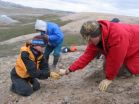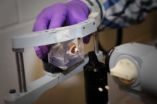(Press-News.org) Stem cell scientists had what first appeared to be an easy win for regenerative medicine when they discovered mesenchymal stem cells several decades ago. These cells, found in the bone marrow, can give rise to bone, fat, and muscle tissue, and have been used in hundreds of clinical trials for tissue repair. Unfortunately, the results of these trials have been underwhelming. One problem is that these stem cells don't stick around in the body long enough to benefit the patient.
But Harvard Stem Cell Institute (HSCI) scientists at Boston Children's Hospital aren't ready to give up. A research team led by Juan Melero-Martin, PhD, recently found that transplanting mesenchymal stem cells along with blood vessel-forming cells naturally found in circulation improves results. This co-transplantation keeps the mesenchymal stem cells alive longer in mice after engraftment, up to a few weeks compared to hours without co-transplantation. This improved survival gives the mesenchymal stem cells sufficient time to display their full regenerative potential, generating new bone or fat tissue in the recipient mouse body. The finding was published in the Proceedings of the National Academy of Sciences (PNAS).
"We are losing mesenchymal stem cells very rapidly when we transplant them into the body, in part, because we are not giving them what they need," said Melero-Martin, an HSCI affiliated faculty member and an assistant professor of surgery at Boston Children's Hospital, Harvard Medical School.
"In the body, these cells sit very close to the capillaries, constantly receiving signals from them, and even though this communication is broken when we isolate mesenchymal stem cells in a laboratory dish, they seem to be ok because we have learned how to feed them," he said. "But when you put the mesenchymal stem cells back into the body, there is a period of time when they will not have this proximity to capillary cells and they start to die; so including these blood vessel-forming cells from the very beginning of a transplantation made a major difference."
Melero-Martin's research has immediate translational implications, as current mesenchymal clinical trials don't follow a co-transplantation procedure. He is already collaborating with surgical colleagues at Boston Children's Hospital to see if his discovery can help improve fat and bone grafts. However, giving patients two different types of cells, as opposed to just one, would require more time and experiments to determine safety and efficacy. Melero-Martin is seeking to identify the specific signals mesenchymal stem cells receive from the blood vessel-forming cells in order to be able to mimic the signals without the cells themselves.
"Even though mesenchymal stem cells have been around for a while, I think there is still a lack of fundamental knowledge about communication between them and other cells in the body," he said. "My lab is interested in going even beyond what we found to try to understand whether these cell-cell signals are different in each tissue of the body, and to learn how to educate both blood vessel-forming and mesenchymal stem cells to co-ordinate tissue specific regenerative responses."
Other Harvard Stem Cell Institute researchers are studying mesenchymal stem cells as bioengineering tools to deliver therapeutics, which is possible because of the cell type's unique ability to not trigger an immune response. Jeffrey Karp, PhD, at Brigham and Women's Hospital has developed several methods to turn these cells into drug-delivery vehicles, so that after transplantation they can, for example, hone in on swollen tissue and secrete anti-inflammatory compounds. And Khalid Shah, PhD, at Massachusetts General Hospital has designed a gel that holds mesenchymal stem cells in place so that they can expose brain tumors to cancer-killing herpes viruses.
"A lot of these applications have no real direct link with mesenchymal stem cells' supposed progenitor cell function," Melero-Martin said. "In our study, we went back to the collective ambition to use these cells as a way to regenerate tissues and we are not in a position to say how that affects other uses that people are proposing."
INFORMATION:
This work was supported by the National Institutes of Health. Ruei-Zeng Lin, PhD, a research fellow in surgery at Boston Children's Hospital, is first author on the PNAS paper.
Cited: Lin, et. al., "Human endothelial colony-forming cells serve as trophic mediators for mesenchymal stem cell engraftment via paracrine signaling" Proceedings of the National Academy of Sciences (June 30, 2014), doi: 10.1073/pnas.1405388111
Research team pursues techniques to improve elusive stem cell therapy
Mesenchymal stem cells have become attractive tools for bioengineers, but some scientists haven't given up on their regenerative potential
2014-06-30
ELSE PRESS RELEASES FROM THIS DATE:
Oil palm plantations threaten water quality, Stanford scientists say
2014-06-30
If you've gone grocery shopping lately, you've probably bought palm oil.
Found in thousands of products, from peanut butter and packaged bread to shampoo and shaving cream, palm oil is a booming multibillion-dollar industry. While it isn't always clearly labeled in supermarket staples, the unintended consequences of producing this ubiquitous ingredient have been widely publicized.
The clearing of tropical forests to plant oil palm trees releases massive amounts of carbon dioxide, a greenhouse gas fueling climate change. Converting diverse forest ecosystems to these ...
New study: Ancient Arctic sharks tolerated brackish water 50 million years ago
2014-06-30
Sharks were a tolerant bunch some 50 million years ago, cruising an Arctic Ocean that contained about the same percentage of freshwater as Louisiana's Lake Ponchatrain does today, says a new study involving the University of Colorado Boulder and the University of Chicago.
The study indicates the Eocene Arctic sand tiger shark, a member of the lamniform group of sharks that includes today's great white, thresher and mako sharks, was thriving in the brackish water of the western Arctic Ocean back then. In contrast, modern sand tiger sharks living today in the Atlantic Ocean ...
First pediatric autism study conducted entirely online
2014-06-30
UC San Francisco researchers have completed the first Internet-based clinical trial for children with autism, establishing it as a viable and cost effective method of conducting high-quality and rapid clinical trials in this population.
In their study, published in the June 2014 issue of the Journal of the American Academy of Child and Adolescent Psychiatry, the researchers looked at whether an Internet-based trial was a feasible way to evaluate whether omega-3 fatty acids helped reduce hyperactivity in children with autism. The authors found that not only was it a valuable ...
Research proves shock wave from explosives causes significant eye damage
2014-06-30
Researchers at The University of Texas at San Antonio (UTSA) are discovering that the current protective eyewear used by our U.S. armed forces might not be adequate to protect soldiers exposed to explosive blasts.
According to a recent study, ocular injuries now account for 13 percent of all battlefield injuries and are the fourth most common military deployment-related injury.
With the support of the U.S. Department of Defense, UTSA biomedical engineering assistant professor Matthew Reilly and distinguished senior lecture in geological sciences Walter Gray have been ...
Earth-Kind roses analyzed for salt tolerance
2014-06-30
COLLEGE STATION, TX – Earth-Kind® roses are favorites with gardeners and landscapers. Chosen for their superior tolerance to heat, drought, and pests, as well as their outstanding performance in landscapes, Earth-Kind® roses can thrive in most environments, even with limited care. A new study focused on determining the best Earth-Kind® varieties for withstanding the challenges of salt stress.
As alternative water sources such as reclaimed water are becoming more commonly used as irrigation for urban landscapes and agricultural crops, plants are being subjected to higher ...
New method to grow zebrafish embryonic stem cells can regenerate whole fish
2014-06-30
New Rochelle, NY, June 30, 2014—Zebrafish, a model organism that plays an important role in biological research and the discovery and development of new drugs and cell-based therapies, can form embryonic stem cells (ESCs). For the first time, researchers report the ability to maintain zebrafish-derived ESCs for more than 2 years without the need to grow them on a feeder cell layer, in a study published in Zebrafish, a peer-reviewed journal from Mary Ann Liebert, Inc., publishers. The article is available free on the Zebrafish website.
Ho Sing Yee and coauthors from the ...
With climate change, heat more than natural disasters will drive people away
2014-06-30
Although scenes of people fleeing from dramatic displays of Mother Nature's power dominate the news, gradual increases in an area's overall temperature — and to a lesser extent precipitation — actually lead more often to permanent population shifts, according to Princeton University research.
The researchers examined 15 years of migration data for more than 7,000 families in Indonesia and found that increases in temperature and, to a lesser extent, rainfall influenced a family's decision to permanently migrate to another of the country's provinces. They report in the ...
Study of animal urination could lead to better-engineered products
2014-06-30
Sir Isaac Newton probably wasn't thinking about how animals urinate when he was developing his laws of gravity. But they are connected – by the urethra, to be specific.
A new Georgia Institute of Technology study investigated how quickly 32 animals urinate. It turns out that it's all about the same. Even though an elephant's bladder is 3,600 times larger than a cat's (18 liters vs. 5 milliliters), both animals relieve themselves in about 20 seconds. In fact, all animals that weigh more than 3 kilograms (6.6 pounds) urinate in that same time span.
"It's possible because ...
Comparison study of planting methods shows drilling favorable for organic farming
2014-06-30
SALINAS, CA – In the fertile growing regions of the central coast of California, scientists are looking for ways to increase organic production of strawberry and other crops. Because cover crops can provide weed and erosion control, determining the best method for establishing a uniform and dense cover crop stand as soon as possible after planting is a critical first step. The authors of a new study say that determining optimal planting strategies that accelerate cover crop emergence and reduce light penetration to weeds should be a primary focus. Eric Brennan and Jim Leap ...
Surgical treatment for metastatic melanoma of the liver increases overall survival
2014-06-30
CHICAGO (June 30, 2014): Surgical resection markedly improves survival among metastatic melanoma patients whose disease is isolated to a few areas in the liver, according to new study findings published in the July issue of the Journal of the American College of Surgeons. These results mark a departure for melanoma, an aggressive form of skin cancer, that is most often considered fatal once it has spread to the liver and then, not amenable to surgical treatment.
In the past, surgical treatment for liver metastases was not considered an option for most patients, as the ...
LAST 30 PRESS RELEASES:
Why nail-biting, procrastination and other self-sabotaging behaviors are rooted in survival instincts
Regional variations in mechanical properties of porcine leptomeninges
Artificial empathy in therapy and healthcare: advancements in interpersonal interaction technologies
Why some brains switch gears more efficiently than others
UVA’s Jundong Li wins ICDM’S 2025 Tao Li Award for data mining, machine learning
UVA’s low-power, high-performance computer power player Mircea Stan earns National Academy of Inventors fellowship
Not playing by the rules: USU researcher explores filamentous algae dynamics in rivers
Do our body clocks influence our risk of dementia?
Anthropologists offer new evidence of bipedalism in long-debated fossil discovery
Safer receipt paper from wood
Dosage-sensitive genes suggest no whole-genome duplications in ancestral angiosperm
First ancient human herpesvirus genomes document their deep history with humans
Why Some Bacteria Survive Antibiotics and How to Stop Them - New study reveals that bacteria can survive antibiotic treatment through two fundamentally different “shutdown modes”
UCLA study links scar healing to dangerous placenta condition
CHANGE-seq-BE finds off-target changes in the genome from base editors
The Journal of Nuclear Medicine Ahead-of-Print Tip Sheet: January 2, 2026
Delayed or absent first dose of measles, mumps, and rubella vaccination
Trends in US preterm birth rates by household income and race and ethnicity
Study identifies potential biomarker linked to progression and brain inflammation in multiple sclerosis
Many mothers in Norway do not show up for postnatal check-ups
Researchers want to find out why quick clay is so unstable
Superradiant spins show teamwork at the quantum scale
Cleveland Clinic Research links tumor bacteria to immunotherapy resistance in head and neck cancer
First Editorial of 2026: Resisting AI slop
Joint ground- and space-based observations reveal Saturn-mass rogue planet
Inheritable genetic variant offers protection against blood cancer risk and progression
Pigs settled Pacific islands alongside early human voyagers
A Coral reef’s daily pulse reshapes microbes in surrounding waters
EAST Tokamak experiments exceed plasma density limit, offering new approach to fusion ignition
Groundbreaking discovery reveals Africa’s oldest cremation pyre and complex ritual practices
[Press-News.org] Research team pursues techniques to improve elusive stem cell therapyMesenchymal stem cells have become attractive tools for bioengineers, but some scientists haven't given up on their regenerative potential





